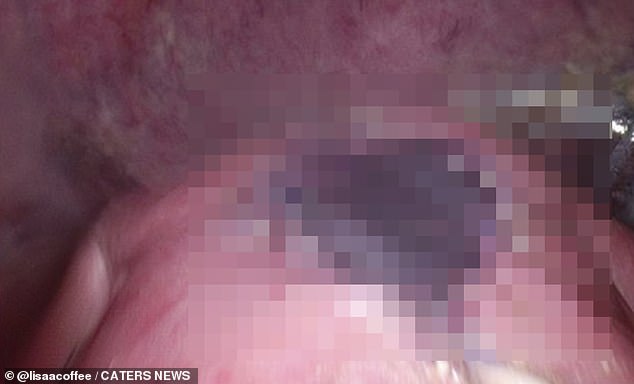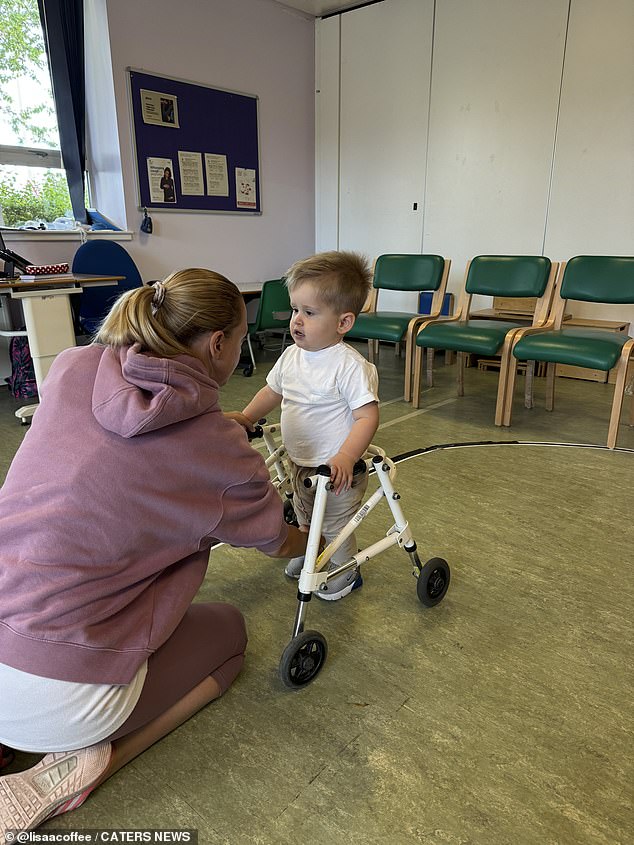A Kent mother has told her amazing birth story, in which her son Luca was “born twice” – once at six months and again at just under nine months.
Lisa Coffee, 23, was told early in her pregnancy that Luca had developed a birth defect, spina bifida, which causes a malformation of the spine and spinal cord.
Specialists opted to extract Luca from his mother’s uterus at 27 weeks (six months) and perform an operation to repair part of the defect.
They then placed him back into her womb and the pregnancy continued until Luca was born at 38 weeks – just under full term.
One-year-old Luca Coffee was born ‘twice’ as part of an astonishing medical procedure to repair damage caused by spina bifida

Luca will not be able to walk, but his mobility can improve with physical therapy, doctors advise
After eight days in the NICU (Neonatal Intensive Care Unit), Mrs. Coffee was able to take her baby home.
However, the family has been told that it is unlikely Luca will be able to walk. The newborn also had to undergo multiple surgeries to repair damage to his brain and spine.
Luca only has a scar on his back and a condition known as Chiari malformation, where part of the brain (the cerebellum) extends into the spinal canal.
He is now making progress through his physiotherapy sessions, which offers hope for his future.
“The cerebellum is still improving,” Coffee said. “There is some fluid in the brain, but it has remained stable, so there has been no need to put a drain in.”
‘His next MRI won’t be until he’s two.
“He’s an amazing kid and we couldn’t be more grateful for how far he’s come. I’m incredibly thankful that the surgery has given him the opportunity to walk one day.”
According to research, around 600 babies are born with spina bifida each year in the UK.

Doctors removed Luca from Ms Coffee’s womb at six months into her pregnancy.

Some people with the mildest form of spina bifida (the hidden form) may not even know they have it.

Around 600 babies are born with spina bifida each year in the UK, but only 1 in 1,000 will be considered for operations similar to the one Luca underwent.
It occurs when, during development, the spine and spinal cord do not form normally.
During development, these structures, along with the brain, arise from something called the neural tube, a precursor to the central nervous system, as well as the protective tissues that form around it.
Normally, this tube forms and closes around the 28th week of pregnancy.
But in babies with spina bifida, it doesn’t close properly, for reasons that aren’t entirely clear to scientists.
Instead, these babies are left with a gap in their vertebrae through which part of the spinal cord can slide, depending on the severity.
People with the mildest form of spina bifida (the hidden form) may not even know they have it.
The space between their vertebrae is so small that the spinal cord remains in place and they are unlikely to experience any neurological or motor symptoms.
The most severe form of the disease is open spina bifida, or myelomeningocele, in which there are larger or multiple openings along the spine.

The newborn had to undergo multiple surgeries to repair damage to his brain and spine.
The membranes, spinal nerves and tissues they are supposed to protect are removed from the baby at birth.
Symptoms vary greatly depending on where and how severe these openings are.
Some children may develop little more than skin problems, while others with severe forms may be unable to walk or move properly, or develop infections such as meningitis that can leave them with permanent brain damage.
Ensuring that women get enough folic acid during pregnancy can help ensure that the spinal cord develops properly.
Typically, surgeons repair these defects after birth. However, in a small number of cases, the procedures can be performed while the baby is still in the womb.
Speaking about these remarkable operations, NHS GP Dr Hana Patel said:
‘It is rare; only 1 in 1,000 pregnancies requires this type of operation.
‘In this case, the fetus needed surgery while the mother was pregnant. It is usually performed to treat a life-threatening birth defect.
It is also performed to repair spina bifida (myelomeningocele), improving outcomes for children born with this condition.
Many children with spina bifida survive into adulthood with proper treatment and care. The estimated average age of a person with spina bifida is 40 years.
“Although living with this disease is often difficult, many people are able to lead independent and fulfilling lives.”


